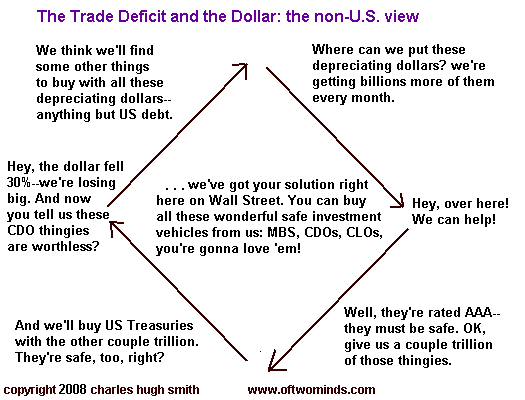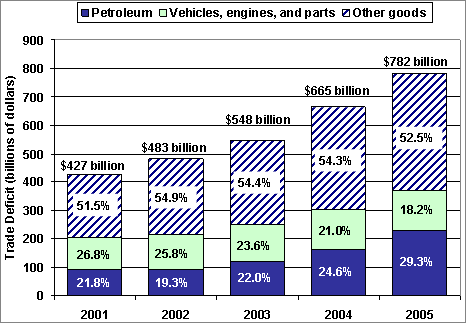Why We're in this Handbasket--and It's Getting Hotter (Part 1)
Not to put too fine a point on it--but why are we in this handbasket, sliding ever faster down a tunnel toward a glowing red opening surrounded by grinning red creatures with pitchforks in hand?
There are many reasons, but let's tackle two of the biggies: the surfeit of dollars and the Pyrrhic triumph of U.S.-created leverage/exotic financial instruments.
The first thing to note about the dollar is that people overseas have been accumulating stupendous mountains of them for some time. As we all know, the U.S. has been importing far more goods and commodities than it has been exporting; this is the current account deficit or trade deficit. Here is a snapshot 2001-2005 courtesy of U.S. Department of Energy.
According to the Commerce Department, here's the trade deficit 1999-2008:
1999: $270 B 2000: $370 B 2001-2005: see above2006: $763 B 2007: $711 B 2008: 750 B (est.)
That adds up to $5.76 trillion. A trillion here, a trillion there, and pretty soon we're talking real money.
By broader measures, the U.S. imbalance is more on the order of $1 trillion a year-- that is, the U.S. requires inflows of $1 trillion a year:
The global current account deficit of the United States is now larger than it has ever been— nearing $800 billion, almost 7 percent of US GDP. To finance both the current account deficit and its own sizable foreign investments, the United States must import about $1 trillion of foreign capital every year or more than $4 billion every working day. The situation is unsustainable in both international financial and domestic political (i.e., trade policy) terms. Correcting it must be the highest priority for US foreign economic policy. The most constructive remedy in the short term is a three-part package that includes credible, sizable reductions in the US budget deficit, expansion of domestic demand in major economies outside the United States, and a gradual but substantial realignment of exchange rates.
(source: Peterson Institute)
For an in-depth look at the damage done, take a look at this National Bureau of Economic Research paper: The Unsustainable US Current Account Position Revisited.(Cost is $5)
Here are some of the mechanisms which have been at work:
1. U.S. consumers spend $3 trillion more in 2000-2007 than they would have in previous decades, mostly by extracting housing-bubble "wealth" from their homes and adding to consumer credit cards and other debt.
2. U.S. businesses prospered not by increasing capital investments in the U.S. but by shipping manufacturing overseas and importing trillions in overseas goods. This enabled corporate profits to zoom even as U.S. wages were stagnant and sales were so-so.
3. Financial gaming grew to dominate U.S. corporate profits: companies which made things to sell domestically and abroad were outstripped by corporations which manufactured nothing but exotic financial instruments like CDOs, CLOs, credit swaps, mortgage-backed securities, asset-backed securities, etc. As The Economist explains:
The financial system--What went wrong:
The American financial-services industry's share of total corporate profits rose from 10% in the early 1980s to 40% at its peak last year. Its share of stock market value grew from 6% to 19%. These proportions look all the more striking—even unsustainable—when you note that financial services account for only 15% of corporate America's gross value added and a mere 5% of private-sector jobs. So 5% of the U.S. workforce made 40% of the total corporate profits from playing around with risky, hard-to-understand paper.
Meanwhile, from the non-U.S. point of view, the question was pressing: what the heck do we do with all these bloody dollars we're accumulating? Having sold the U.S. $6 trillion dollars worth of oil, car parts, Wal-Mart goods, etc. in excess of what they purchased from the U.S., these non-U.S. governments and companies were stuck with a stupendous and ever-growing mountain of greenbacks.
That led to a shotgun marriage which was made in Heaven for Wall Street and straight from Hell for the hapless foreign buyers. Wall Street sharpies conjured up a whole universe of debt instruments to sell to foreign banks, pension funds, companies, etc. who were seeking somewhere to put their bucks in a world awash with dollars, credit and cash.
Here's a chart to depict what happened:
The global boom--largely a product of the global housing bubble and the global credit bubble--created trillions in profits for every player: Japan, China, the EU, USA, etc. The players were all chasing returns, and all were looking for some place to dump their depreciating dollars.
And why were they depreciating? Simple supply and demand: there were too many dollars being "printed" via bank leverage (take $1 cash, use it to create $100 loan on a rapidly appreciating house somewhere like Florida, Arizona or California) and then shipped overseas to pay for the outrageous, stunning amount of goods and commodities the U.S. was consuming--i.e., the trade deficit.
Apparently fear is so rampant in the global financial markets nowadays that despite losing value virtually every day, foreign entities are still buying short-term U.S. Treasuries. This has enabled the U.S. to keep borrowing hundreds of billions to lavish on giveaways to poor U.S. consumers, (the $160 billion giveaway), the $500 billion war in Iraq, etc.
What drives this desperate buying of U.S. debt even as the dollar sinks? There is no place else to put the trillions of dollars piling up overseas. Some dollars are flowing back to buy U.S. real estate or U.S. companies, but investors who stepped up and bought a chunk of Bear Stearns or Citicorp have been burned--so U.S. assets might actually be riskier and more dangerous than T-bills which earn less than the dollar depreciates. In other words, buy a T-Bill for $1 and get back 95 cents--such a deal! At least you got back something!
In a saner world, non-U.S. players would stop exporting so much to the U.S. and save themselves the trouble of losing money in the dollar and U.S. debt. But then who else will step up and buy 25% of the global GDP?
It's a conundrum, to be sure, but one with an eventual end. As explained in the book The Dollar Crisis: Causes, Consequences, Cures the eventual cure is the rebalancing of trade via recalibrations of currencies. In effect, the author builds a strong case that all massive, structural trade imbalances like the one the U.S. has enjoyed/engineered for the past 10 years come to an end when the currency (in this case, the dollar) drops so low that imports and exports reach rough parity.
Take another look at that U.S. Dept. of Energy chart. A sharp recession and a stiff contraction of credit might well cut demand for foreign autos and for oil, too-- which make up half of the trade deficit. It would be a start toward righting the trade imbalance, and toward shipping fewer dollars overseas to be gambled/mis-invested/dumped.
NOTE: contributions are humbly acknowledged in the order received. Your name and email remain confidential and will not be given to any other individual, company or agency.
Thank you, Eric A. ($20), for your generous financial support of this humble site, and most especially for your wise words of encouragement. I am greatly honored by your contributions and readership. All contributors are listed below in acknowledgement of my gratitude.
Tuesday, March 25, 2008
Terms of Service
All content on this blog is provided by Trewe LLC for informational purposes only. The owner of this blog makes no representations as to the accuracy or completeness of any information on this site or found by following any link on this site. The owner will not be liable for any errors or omissions in this information nor for the availability of this information. The owner will not be liable for any losses, injuries, or damages from the display or use of this information. These terms and conditions of use are subject to change at anytime and without notice.
Our Privacy Policy:
Correspondents' email is strictly confidential. This site does not collect digital data from visitors or distribute cookies. Advertisements served by a third-party advertising network (Investing Channel) may use cookies or collect information from visitors for the purpose of Interest-Based Advertising; if you wish to opt out of Interest-Based Advertising, please go to Opt out of interest-based advertising (The Network Advertising Initiative). If you have other privacy concerns relating to advertisements, please contact advertisers directly. Websites and blog links on the site's blog roll are posted at my discretion.
PRIVACY NOTICE FOR EEA INDIVIDUALS
This section covers disclosures on the General Data Protection Regulation (GDPR) for users residing within EEA only. GDPR replaces the existing Directive 95/46/ec, and aims at harmonizing data protection laws in the EU that are fit for purpose in the digital age. The primary objective of the GDPR is to give citizens back control of their personal data. Please follow the link below to access InvestingChannel’s General Data Protection Notice. https://stg.media.investingchannel.com/gdpr-notice/
Notice of Compliance with
The California Consumer Protection Act
This site does not collect digital data from visitors or distribute cookies.
Advertisements served by a third-party advertising network
(Investing Channel) may use cookies or collect information from visitors for the
purpose of Interest-Based Advertising. If you do not want any personal information
that may be collected by third-party advertising to be sold, please
follow the instructions on this page:
Limit the Use of My Sensitive Personal Information.
Regarding Cookies:
This site does not collect digital data from visitors or distribute cookies. Advertisements served by third-party advertising networks such as Investing Channel may use cookies or collect information from visitors for the purpose of Interest-Based Advertising; if you wish to opt out of Interest-Based Advertising, please go to Opt out of interest-based advertising (The Network Advertising Initiative) If you have other privacy concerns relating to advertisements, please contact advertisers directly.
Our Commission Policy:
As an Amazon Associate I earn from qualifying purchases. I also earn a commission on purchases of precious metals via BullionVault. I receive no fees or compensation for any other non-advertising links or content posted on my site.



























